2019 KIA SOUL child lock
[x] Cancel search: child lockPage 107 of 564
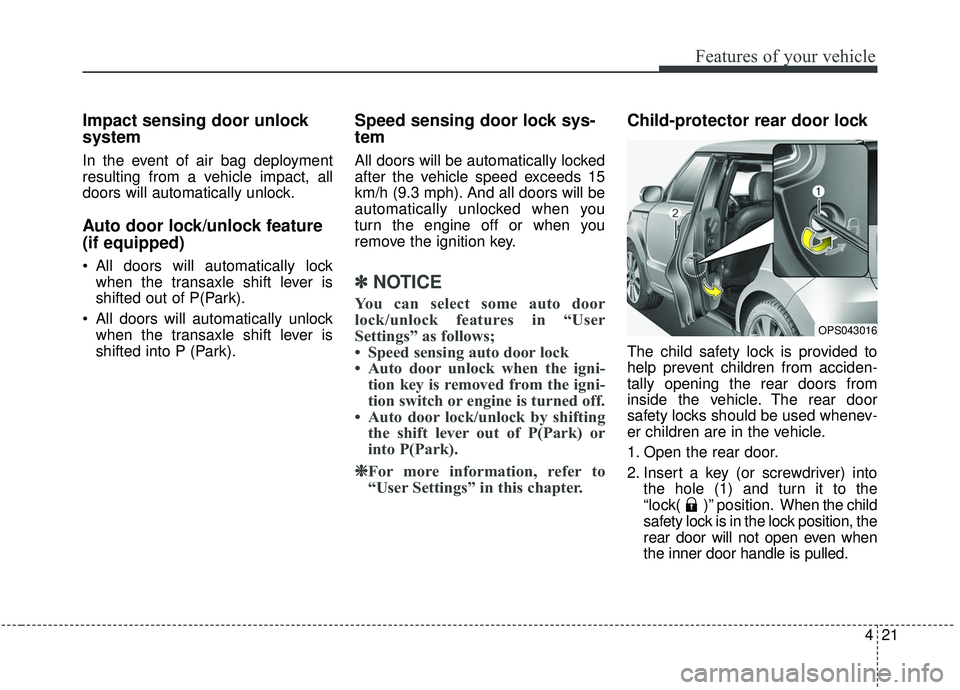
421
Features of your vehicle
Impact sensing door unlock
system
In the event of air bag deployment
resulting from a vehicle impact, all
doors will automatically unlock.
Auto door lock/unlock feature
(if equipped)
All doors will automatically lockwhen the transaxle shift lever is
shifted out of P(Park).
All doors will automatically unlock when the transaxle shift lever is
shifted into P (Park).
Speed sensing door lock sys-
tem
All doors will be automatically locked
after the vehicle speed exceeds 15
km/h (9.3 mph). And all doors will be
automatically unlocked when you
turn the engine off or when you
remove the ignition key.
✽ ✽ NOTICE
You can select some auto door
lock/unlock features in “User
Settings” as follows;
• Speed sensing auto door lock
• Auto door unlock when the igni-
tion key is removed from the igni-
tion switch or engine is turned off.
• Auto door lock/unlock by shifting the shift lever out of P(Park) or
into P(Park).
❈ ❈ For more information, refer to
“User Settings” in this chapter.
Child-protector rear door lock
The child safety lock is provided to
help prevent children from acciden-
tally opening the rear doors from
inside the vehicle. The rear door
safety locks should be used whenev-
er children are in the vehicle.
1. Open the rear door.
2. Insert a key (or screwdriver) into
the hole (1) and turn it to the
“lock( )” position. When the child
safety lock is in the lock position, the
rear door will not open even when
the inner door handle is pulled.
OPS043016
Page 108 of 564
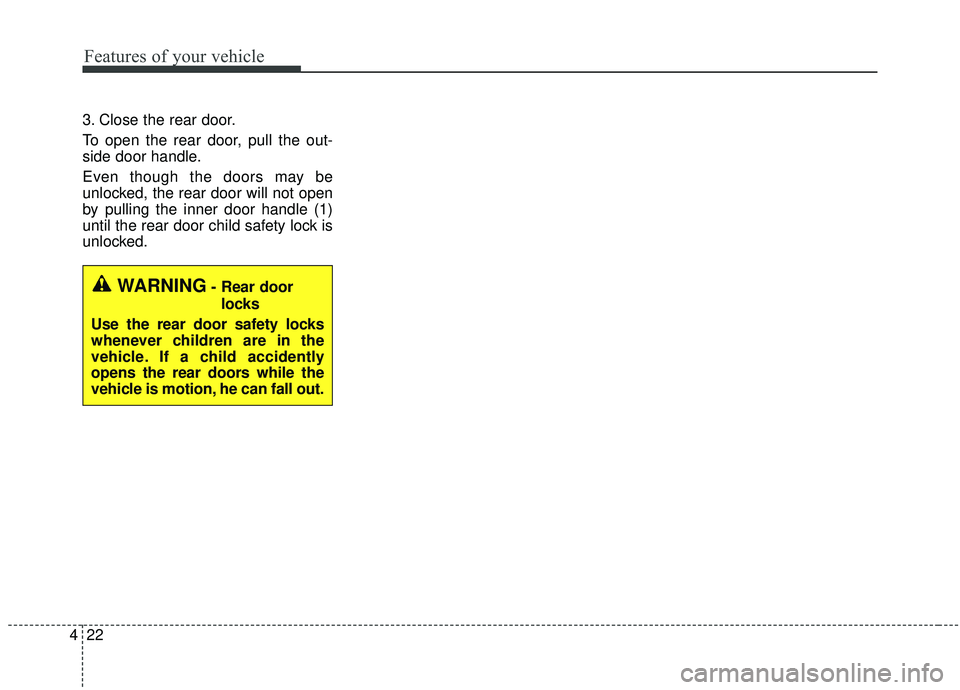
Features of your vehicle
22
4
3. Close the rear door.
To open the rear door, pull the out-
side door handle.
Even though the doors may be
unlocked, the rear door will not open
by pulling the inner door handle (1)
until the rear door child safety lock is
unlocked.
WARNING- Rear door
locks
Use the rear door safety locks
whenever children are in the
vehicle. If a child accidently
opens the rear doors while the
vehicle is motion, he can fall out.
Page 116 of 564
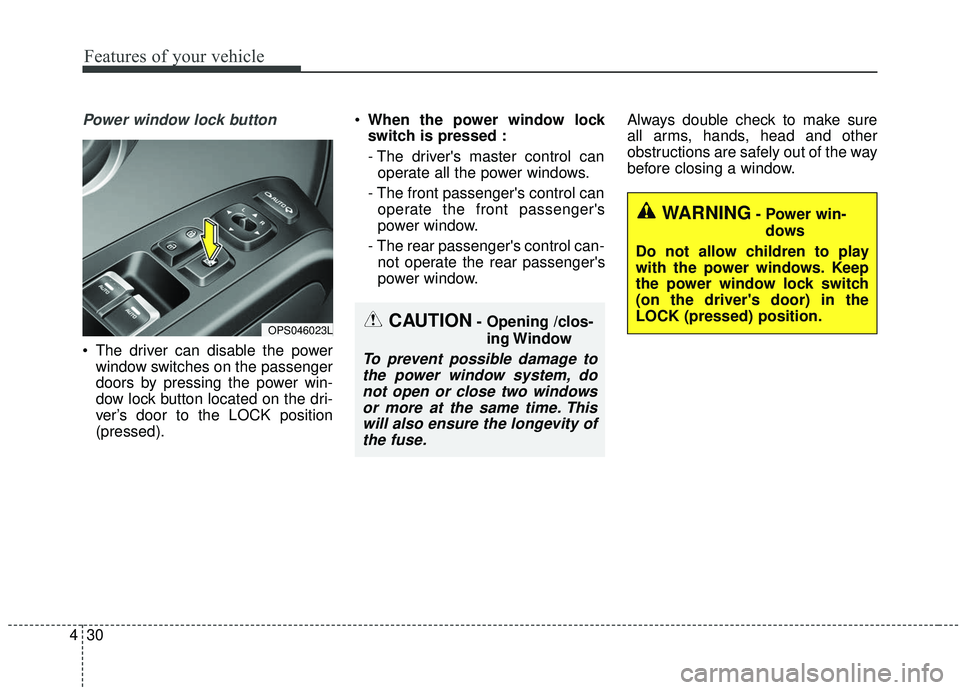
Features of your vehicle
30
4
Power window lock button
The driver can disable the power
window switches on the passenger
doors by pressing the power win-
dow lock button located on the dri-
ver’s door to the LOCK position
(pressed).
When the power window lock
switch is pressed :
- The driver's master control can
operate all the power windows.
- The front passenger's control can operate the front passenger's
power window.
- The rear passenger's control can- not operate the rear passenger's
power window. Always double check to make sure
all arms, hands, head and other
obstructions are safely out of the way
before closing a window.
OPS046023LCAUTION- Opening /clos-
ing Window
To prevent possible damage tothe power window system, donot open or close two windowsor more at the same time. Thiswill also ensure the longevity ofthe fuse.
WARNING- Power win-
dows
Do not allow children to play
with the power windows. Keep
the power window lock switch
(on the driver's door) in the
LOCK (pressed) position.
Page 122 of 564
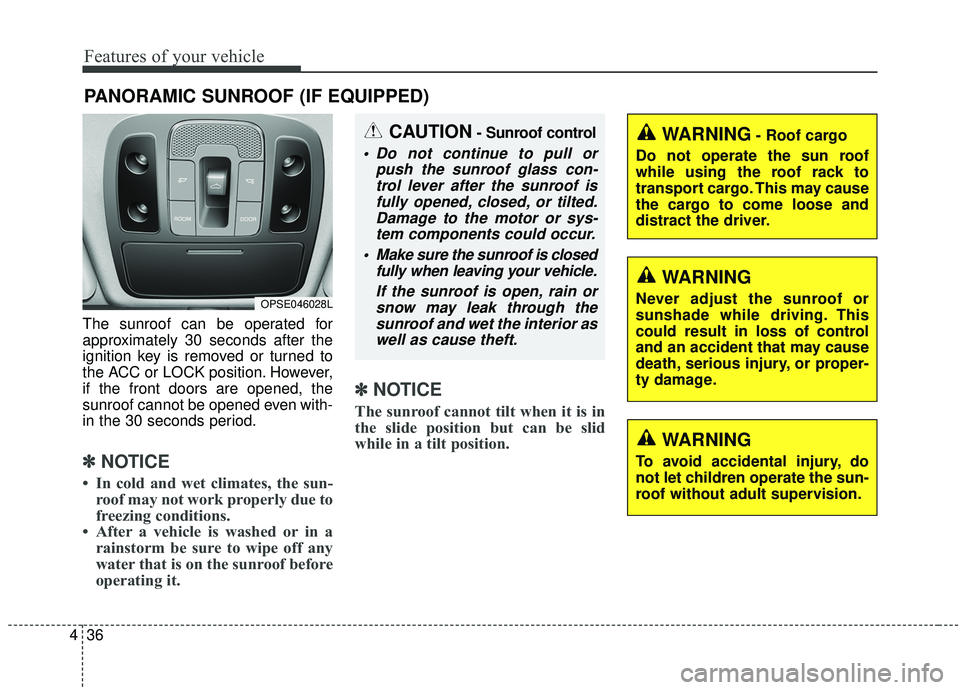
Features of your vehicle
36
4
The sunroof can be operated for
approximately 30 seconds after the
ignition key is removed or turned to
the ACC or LOCK position. However,
if the front doors are opened, the
sunroof cannot be opened even with-
in the 30 seconds period.
✽ ✽
NOTICE
• In cold and wet climates, the sun-
roof may not work properly due to
freezing conditions.
• After a vehicle is washed or in a rainstorm be sure to wipe off any
water that is on the sunroof before
operating it.
✽ ✽ NOTICE
The sunroof cannot tilt when it is in
the slide position but can be slid
while in a tilt position.
PANORAMIC SUNROOF (IF EQUIPPED)
CAUTION- Sunroof control
Do not continue to pull or
push the sunroof glass con-trol lever after the sunroof isfully opened, closed, or tilted.Damage to the motor or sys-tem components could occur.
Make sure the sunroof is closed fully when leaving your vehicle.
If the sunroof is open, rain orsnow may leak through thesunroof and wet the interior aswell as cause theft.
OPSE046028L
WARNING- Roof cargo
Do not operate the sun roof
while using the roof rack to
transport cargo. This may cause
the cargo to come loose and
distract the driver.
WARNING
Never adjust the sunroof or
sunshade while driving. This
could result in loss of control
and an accident that may cause
death, serious injury, or proper-
ty damage.
WARNING
To avoid accidental injury, do
not let children operate the sun-
roof without adult supervision.
Page 303 of 564
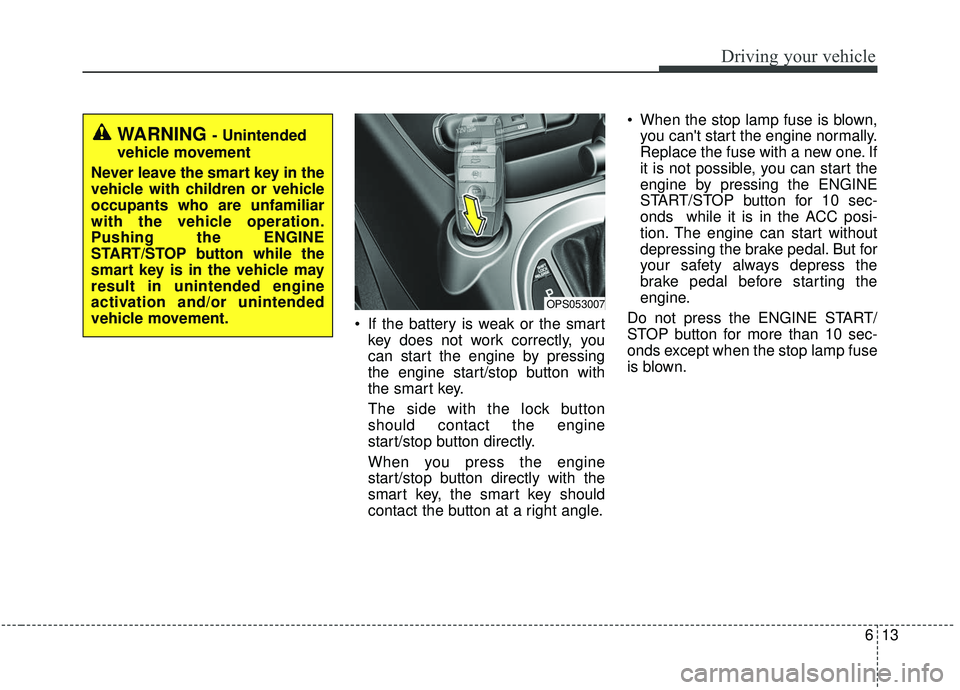
613
Driving your vehicle
If the battery is weak or the smartkey does not work correctly, you
can start the engine by pressing
the engine start/stop button with
the smart key.
The side with the lock button
should contact the engine
start/stop button directly.
When you press the engine
start/stop button directly with the
smart key, the smart key should
contact the button at a right angle. When the stop lamp fuse is blown,
you can't start the engine normally.
Replace the fuse with a new one. If
it is not possible, you can start the
engine by pressing the ENGINE
START/STOP button for 10 sec-
onds while it is in the ACC posi-
tion. The engine can start without
depressing the brake pedal. But for
your safety always depress the
brake pedal before starting the
engine.
Do not press the ENGINE START/
STOP button for more than 10 sec-
onds except when the stop lamp fuse
is blown.
OPS053007
WARNING - Unintended
vehicle movement
Never leave the smart key in the
vehicle with children or vehicle
occupants who are unfamiliar
with the vehicle operation.
Pushing the ENGINE
START/STOP button while the
smart key is in the vehicle may
result in unintended engine
activation and/or unintended
vehicle movement.
Page 317 of 564

627
Driving your vehicle
The dual clutch transmission canbe thought of as an automatically
shifting manual transaxle. It gives
the driving feel of a manual
transaxle, yet provides the ease of
a fully automatic transaxle.
When D (Drive) is selected, the transmission will automatically shift
through the gears similar to a con-
ventional automatic transaxle.
Unlike a traditional automatic
transaxle, the gear shifting can
sometimes be felt and heard as the
actuators engage the clutches and
the gears are selected.
The dual clutch transmission adopts a dry-type dual clutch,
which is different from the torque
converter of the automatic
transaxle. It shows better accelera-
tion performance and increased
fuel efficiency while driving but ini-
tial launch might be little bit slower
than the automatic transaxle.
WARNING
To reduce the risk of serious
injury or death:
ALWAYS check the surround-ing areas near your vehicle for
people, especially children,
before shifting a vehicle into
D (Drive) or R (Reverse).
Before leaving the driver’s seat, always make sure the
shift lever is in the P (Park)
position, then set the parking
brake, and place the ignition
switch in the LOCK/OFF posi-
tion. Unexpected and sudden
vehicle movement can occur
if this procedure is not fol-
lowed.
Do not use engine braking (shifting from a high gear to
lower gear) rapidly on slip-
pery roads. The vehicle may
slip causing an accident.
CAUTION
To avoid damage to yourtransaxle, do not try to acceler-ate in R (Reverse) or any for-ward gear position with thebrakes on.
Page 557 of 564
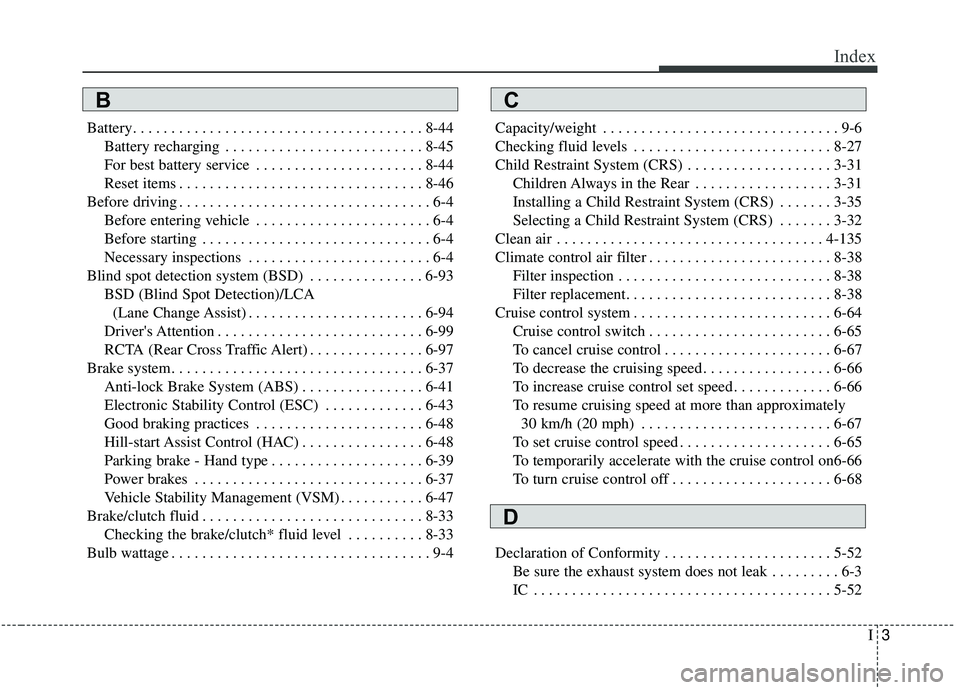
I3
Index
Battery. . . . . . . . . . . . . . . . . . . . . . . . . . . . . . . . . . . . \
. . 8-44Battery recharging . . . . . . . . . . . . . . . . . . . . . . . . . . 8-45
For best battery service . . . . . . . . . . . . . . . . . . . . . . 8-44
Reset items . . . . . . . . . . . . . . . . . . . . . . . . . . . . . . . . 8-46
Before driving . . . . . . . . . . . . . . . . . . . . . . . . . . . . . . . . . 6-4 Before entering vehicle . . . . . . . . . . . . . . . . . . . . . . . 6-4
Before starting . . . . . . . . . . . . . . . . . . . . . . . . . . . . . . 6-4
Necessary inspections . . . . . . . . . . . . . . . . . . . . . . . . 6-4
Blind spot detection system (BSD) . . . . . . . . . . . . . . . 6-93 BSD (Blind Spot Detection)/LCA (Lane Change Assist) . . . . . . . . . . . . . . . . . . . . . . . 6-94
Driver's Attention . . . . . . . . . . . . . . . . . . . . . . . . . . . 6-99
RCTA (Rear Cross Traffic Alert) . . . . . . . . . . . . . . . 6-97
Brake system. . . . . . . . . . . . . . . . . . . . . . . . . . . . . . . . . 6-37 Anti-lock Brake System (ABS) . . . . . . . . . . . . . . . . 6-41
Electronic Stability Control (ESC) . . . . . . . . . . . . . 6-43
Good braking practices . . . . . . . . . . . . . . . . . . . . . . 6-48
Hill-start Assist Control (HAC) . . . . . . . . . . . . . . . . 6-48
Parking brake - Hand type . . . . . . . . . . . . . . . . . . . . 6-39
Power brakes . . . . . . . . . . . . . . . . . . . . . . . . . . . . . . 6-37
Vehicle Stability Management (VSM) . . . . . . . . . . . 6-47
Brake/clutch fluid . . . . . . . . . . . . . . . . . . . . . . . . . . . . . 8-33 Checking the brake/clutch* fluid level . . . . . . . . . . 8-33
Bulb wattage . . . . . . . . . . . . . . . . . . . . . . . . . . . . . . . . . . 9-4 Capacity/weight . . . . . . . . . . . . . . . . . . . . . . . . . . . . . . . 9-6
Checking fluid levels . . . . . . . . . . . . . . . . . . . . . . . . . . 8-27
Child Restraint System (CRS) . . . . . . . . . . . . . . . . . . . 3-31
Children Always in the Rear . . . . . . . . . . . . . . . . . . 3-31
Installing a Child Restraint System (CRS) . . . . . . . 3-35
Selecting a Child Restraint System (CRS) . . . . . . . 3-32
Clean air . . . . . . . . . . . . . . . . . . . . . . . . . . . . . . . . . . . 4-\
135
Climate control air filter . . . . . . . . . . . . . . . . . . . . . . . . 8-38 Filter inspection . . . . . . . . . . . . . . . . . . . . . . . . . . . . 8-38
Filter replacement. . . . . . . . . . . . . . . . . . . . . . . . . . . 8-38
Cruise control system . . . . . . . . . . . . . . . . . . . . . . . . . . 6-64 Cruise control switch . . . . . . . . . . . . . . . . . . . . . . . . 6-65
To cancel cruise control . . . . . . . . . . . . . . . . . . . . . . 6-67
To decrease the cruising speed . . . . . . . . . . . . . . . . . 6-66
To increase cruise control set speed . . . . . . . . . . . . . 6-66
To resume cruising speed at more than approximately 30 km/h (20 mph) . . . . . . . . . . . . . . . . . . . . . . . . . 6-67
To set cruise control speed . . . . . . . . . . . . . . . . . . . . 6-65
To temporarily accelerate with the cruise control on6-66
To turn cruise control off . . . . . . . . . . . . . . . . . . . . . 6-68
Declaration of Conformity . . . . . . . . . . . . . . . . . . . . . . 5-52 Be sure the exhaust system does not leak . . . . . . . . . 6-3
IC . . . . . . . . . . . . . . . . . . . . . . . . . . . . . . . . . . . . \
. . . 5-52
BC
D
Page 558 of 564
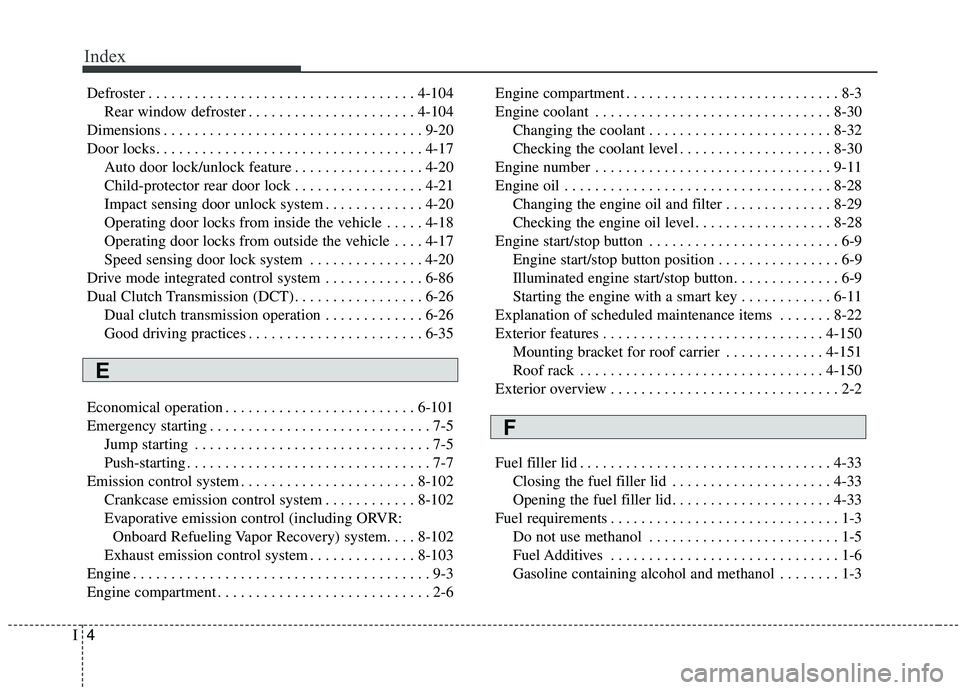
Index
4I
Defroster . . . . . . . . . . . . . . . . . . . . . . . . . . . . . . . . . . . 4-\
104Rear window defroster . . . . . . . . . . . . . . . . . . . . . . 4-104
Dimensions . . . . . . . . . . . . . . . . . . . . . . . . . . . . . . . . . . 9-20\
Door locks. . . . . . . . . . . . . . . . . . . . . . . . . . . . . . . . . . . 4-\
17 Auto door lock/unlock feature . . . . . . . . . . . . . . . . . 4-20
Child-protector rear door lock . . . . . . . . . . . . . . . . . 4-21
Impact sensing door unlock system . . . . . . . . . . . . . 4-20
Operating door locks from inside the vehicle . . . . . 4-18
Operating door locks from outside the vehicle . . . . 4-17
Speed sensing door lock system . . . . . . . . . . . . . . . 4-20
Drive mode integrated control system . . . . . . . . . . . . . 6-86
Dual Clutch Transmission (DCT). . . . . . . . . . . . . . . . . 6-26 Dual clutch transmission operation . . . . . . . . . . . . . 6-26
Good driving practices . . . . . . . . . . . . . . . . . . . . . . . 6-35
Economical operation . . . . . . . . . . . . . . . . . . . . . . . . . 6-101
Emergency starting . . . . . . . . . . . . . . . . . . . . . . . . . . . . . 7-5 Jump starting . . . . . . . . . . . . . . . . . . . . . . . . . . . . . . . 7-5
Push-starting . . . . . . . . . . . . . . . . . . . . . . . . . . . . . . . . 7-7
Emission control system . . . . . . . . . . . . . . . . . . . . . . . 8-102 Crankcase emission control system . . . . . . . . . . . . 8-102
Evaporative emission control (including ORVR:Onboard Refueling Vapor Recovery) system. . . . 8-102
Exhaust emission control system . . . . . . . . . . . . . . 8-103
Engine . . . . . . . . . . . . . . . . . . . . . . . . . . . . . . . . . . . . \
. . . 9-3
Engine compartment . . . . . . . . . . . . . . . . . . . . . . . . . . . . 2-6 Engine compartment . . . . . . . . . . . . . . . . . . . . . . . . . . . . 8-3
Engine coolant . . . . . . . . . . . . . . . . . . . . . . . . . . . . . . . 8-30
Changing the coolant . . . . . . . . . . . . . . . . . . . . . . . . 8-32
Checking the coolant level . . . . . . . . . . . . . . . . . . . . 8-30
Engine number . . . . . . . . . . . . . . . . . . . . . . . . . . . . . . . 9-11
Engine oil . . . . . . . . . . . . . . . . . . . . . . . . . . . . . . . . . . . 8-\
28 Changing the engine oil and filter . . . . . . . . . . . . . . 8-29
Checking the engine oil level . . . . . . . . . . . . . . . . . . 8-28
Engine start/stop button . . . . . . . . . . . . . . . . . . . . . . . . . 6-9 Engine start/stop button position . . . . . . . . . . . . . . . . 6-9
Illuminated engine start/stop button. . . . . . . . . . . . . . 6-9
Starting the engine with a smart key . . . . . . . . . . . . 6-11
Explanation of scheduled maintenance items . . . . . . . 8-22
Exterior features . . . . . . . . . . . . . . . . . . . . . . . . . . . . . 4-150 Mounting bracket for roof carrier . . . . . . . . . . . . . 4-151
Roof rack . . . . . . . . . . . . . . . . . . . . . . . . . . . . . . . . 4-150
Exterior overview . . . . . . . . . . . . . . . . . . . . . . . . . . . . . . 2-2
Fuel filler lid . . . . . . . . . . . . . . . . . . . . . . . . . . . . . . . . . 4-33 Closing the fuel filler lid . . . . . . . . . . . . . . . . . . . . . 4-33
Opening the fuel filler lid. . . . . . . . . . . . . . . . . . . . . 4-33
Fuel requirements . . . . . . . . . . . . . . . . . . . . . . . . . . . . . . 1-3 Do not use methanol . . . . . . . . . . . . . . . . . . . . . . . . . 1-5
Fuel Additives . . . . . . . . . . . . . . . . . . . . . . . . . . . . . . 1-6
Gasoline containing alcohol and methanol . . . . . . . . 1-3
F
E